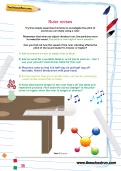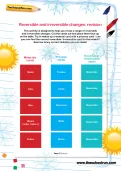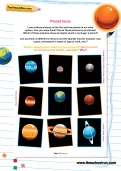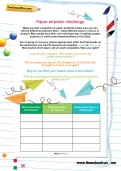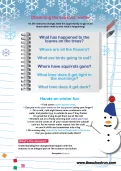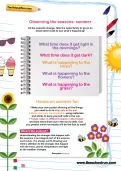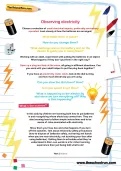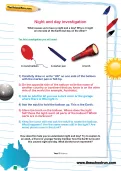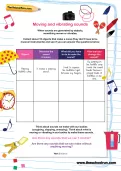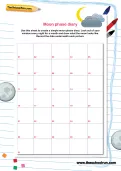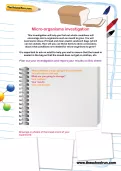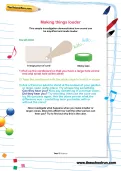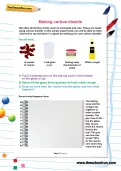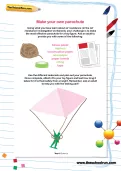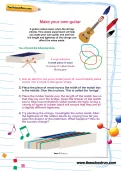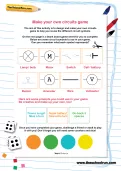Try this simple experiment at home to investigate the pitch of sound you can make using a ruler.
or
Register to add to your saved resources
Already a subscriber? to view this content.
This activity is designed to help you revise a range of reversible and irreversible changes. Cut the cards out and place them face up on the table. Try to match up a material card with a process card – can you now find the correct reversible / irreversible card for this match? See how many correct matches you can make!
or
Register to add to your saved resources
Already a subscriber? to view this content.
Look at these pictures of the Sun and the planets in our solar system. Can you name them? One of these pictures is an intruder! Which of these pictures shows an object which is no longer a planet? Can you think of different criteria to sort the planets into (for example: size, colour, what planet is made of, type of orbit, etc.)?
or
Register to add to your saved resources
Already a subscriber? to view this content.
Make yourself a selection of paper airplanes. You’re going to race your planes against each other, but first decide on the parameters you want to measure (for example, speed or distance). Now predict which plane will win each completion. Were you right?
or
Register to add to your saved resources
Already a subscriber? to view this content.
As the seasons change, take the opportunity to go on an observation walk to see what’s happening! Here are some great ideas for hands-on winter fun!
or
Register to add to your saved resources
As the seasons change, take the opportunity to go on an observation walk to see what’s happening! Here are some great hands-on fun activities for summer!
or
Register to add to your saved resources
As the seasons change, take the opportunity to go on an observation walk to see what’s happening! Here are some great hands-on Spring fun ideas.
or
Register to add to your saved resources
As the seasons change, take the opportunity to go on an observation walk to see what’s happening! Here are lots of suggestions for fun things to look for on your autumn work.
or
Register to add to your saved resources
Choose a selection of small electrical objects, preferably two-battery operated. Look closely at how the batteries are arranged. Open up a plug and look at the wires, all going in different directions. Can you work with your adult helper to put the plug back together? If you have an electricity meter clock, look at the dial turning and how much electricity you are using.
or
Register to add to your saved resources
Already a subscriber? to view this content.
What causes us to have a night and a day? Why is it night on one side of the Earth but day on the other? Let's investigate!
or
Register to add to your saved resources
When sounds are generated by objects, something moves or vibrates. Collect about 10 objects that make a noise (they don’t have to be musical instruments) and see if you can answer these questions.
or
Register to add to your saved resources
Already a subscriber? to view this content.
Use this sheet to create a simple moon phase diary. Look out of your window every night for a month and draw what the moon looks like. Record the date underneath each picture.
or
Register to add to your saved resources
This investigation will help you find out which conditions will encourage micro-organisms such as mould to grow.
or
Register to add to your saved resources
Already a subscriber? to view this content.
This simple investigation demonstrates how sound can be amplified and made louder.
or
Register to add to your saved resources
Already a subscriber? to view this content.
We often drink fizzy drinks such as lemonade and cola. These are made using carbon dioxide. In this simple experiment, you will be able to make raisins dive up and down in a glass by making your own carbon dioxide!
or
Register to add to your saved resources
Already a subscriber? to view this content.
Build your own water cycle and investigate reversible and irreversible changes.
or
Register to add to your saved resources
Already a subscriber? to view this content.
A sundial tells the time by using the position of the sun. This is how it works: the sun casts a shadow onto a surface marked with lines indicating the hours of the day. As the sun moves across the sky
the shadow aligns with different hour-lines. Do you think you can make your own sundial?
or
Register to add to your saved resources
Already a subscriber? to view this content.
Using what you have learned about air resistance, your challenge is to make the most effective parachute for a toy figure.
or
Register to add to your saved resources
Already a subscriber? to view this content.
A guitar makes music when the strings vibrate. This simple experiment will help you make your own guitar and see how the length and tightness of the strings can affect the notes made.
or
Register to add to your saved resources
The aim of this activity is to design and make your own circuits game to help you revise the different circuit symbols.
or
Register to add to your saved resources
Already a subscriber? to view this content.
